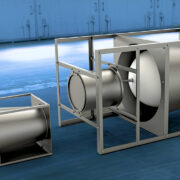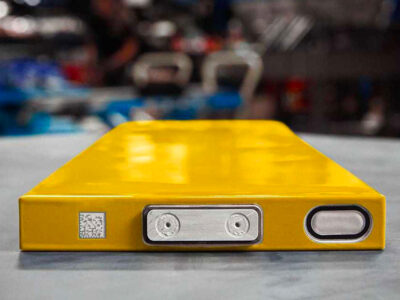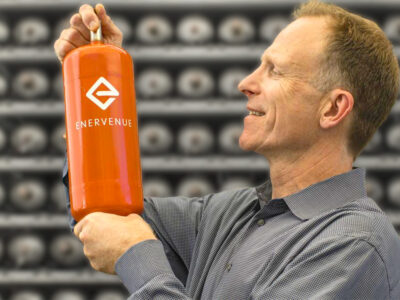Sand. It’s coarse, it’s rough, and it can make for a great battery. And as weird as that might sound, it’s just one example of the many earthy materials currently used for thermal energy storage (or TES). A while back, we covered the debut of the world’s commercial sand battery, which is big enough to supply power for about 10,000 people. Now, sand-based energy storage has reached a new frontier: individual homes. Companies like Batsand are currently offering heat batteries that bring hot and fresh sand directly to your door. Seems you can get just about anything delivered these days.
But what’s stopped us from experimenting with residential TES before? How will heat storage impact our lives in our homes? And where exactly are homeowners supposed to put this stuff?
Your utility bill probably already tells you that we spend a lot of money heating and cooling our homes. In fact, according to the University of Michigan, over 30% of total US residential energy use is dedicated to heating. Water heating comes in at about 13%, which is really just another kind of temperature control.12 According to the U.S. Lawrence Berkeley National Laboratory, one-fifth of all energy produced in the United States goes towards a building’s thermal load.3

University of Michagan Residential Buildings Factsheet
Residential battery systems like the Tesla Powerwall are a great way to get around what some consider the fatal flaw of renewable energy: intermittency. But the dominance of lithium-ion batteries comes with a host of its own downsides — and some of those, like the ecological impact and potential safety issues, can be literally fatal.
Thermal batteries or thermal energy storage (TES) devices are one alternative that’s worth watching. We’ve examined them before, but here’s a quick refresher.
When it comes to TES, the acronym is pretty straightforward: they’re batteries that store energy as heat. You charge them by passing electricity through a heating element embedded in your thermal medium. This medium can be water, sand or whatever, so long as it can hold onto a lot of heat for a long time. We can then discharge and release the heat at a later date through a basic cooling process.4
When used in combination with heat pumps and solar panels, TESs can do some amazing things. As far back as 2012, Drake Landing Solar Community got a record-breaking 96% of their yearly heating from solar energy. In 2015-16, that number jumped 100%. That was in cold, dark Alberta, Canada, of all places! 56
TESs tend to have very good round-trip efficiency rates (RTE), which is the percentage of electricity put into storage that’s later retrieved.7 It’s very important for any kind of energy storage device. A 100% RTE would mean that every drop of energy stored can be withdrawn and used later. It’s also thermodynamically impossible. For context, lead-acid batteries have an RTE of about 70%.8 Lithium-Ion batteries for large energy storage, like those in many industrial-scale energy storage facilities and maybe even your home, have an RTE of around 90%.9 But commercial and industrial thermal batteries are reportedly hitting RTE’s of 90% or more.10111213
This got a lot of innovators thinking… if TESs are working so well for big applications, why not bring them home? But can TESs work on a small scale? And if they can, why haven’t we tried this sooner?
Home Energy Storage and New TES
But first…why sand? I don’t like sand. If you’ve ever visited the beach and made the mistake of ditching your flip flops a little too soon, you’re all too aware that sand holds heat remarkably well. That’s because sand has low specific heat, meaning it doesn’t need a lot of energy to heat up fast. And sand’s high density allows it to store large amounts of thermal energy.14 No chemical reactions means sand batteries are low maintenance and have long life spans.15
We can also heat it to well above the boiling point of water, and hold onto that heat with an RTE well above 90%. For these reasons we’ve seen companies like Polar Night achieve viral buzz around their commercial sand batteries. We just heat the sand with renewable energy, then we use air to move the heat from the sand to your house. Seems easy, so why haven’t we been doing it all along?
The main reason is size. Mass matters, especially for storing heat! I don’t know what your living situation is like, but I don’t really have room in my garage for a 23-foot (7ish meter) tall silo of sand.16
That’s where companies like Latvian-based Batsand come in. It’s difficult to reduce these devices down to a residential size, so Batsand cleverly plans to hide the sand tank underground … not unlike a septic tank. This is a necessity, as even the smallest Batsand tank is going to measure 40 cubic meters. Though it’s not all about space consideration — having a tank underground helps to keep everything well insulated, kinda like a DIY geothermal system.17
Better yet, sand is dirt cheap, non-toxic, and (if it has been properly selected and cleaned of other organic materials) non-flammable.17 Numbers-wise, the device is intended for 300-400 square-meter buildings and can store 10,680 kW/h. That’s impressive, assuming you’ve got the recommended 30-plus kW of solar panels on your property. What’s the catch? We just touched on it … it’s that massive sand tank.17 Just like a geothermal system, digging your yard up isn’t cheap.16 Something to keep in mind for later when we talk about price points.
Netherlands-based Newton Energy Solutions (NES) have a very different kind of TES device to offer, though. They’re keeping it simple with a no-frills design that falls somewhere between a TES, a water heater, and a buffer tank.18 Fun sidenote: a water heater is already a thermal battery, technically speaking. It’s just one that can’t turn the heat back into electricity.19 But seeing as you’re already spending most of your electricity on heat, that’s not much of an issue. No surprise then that the NEStore looks and functions a lot like a water heater. In fact, if you don’t have enough space for both, the NEStore can flat out replace your water heater.20
The NEStore combines special vacuum insulation with thinner-than-average tank walls. Together, these two small advantages allow the NEStore to hold more water and much more heat than other devices in its weight class.19 The system is available in two sizes: The smaller one has water volumes of 214 liters and 20 kWh capacity. The larger one is 320 liters and a 29 kWh capacity. According to NES, even the smaller size can heat 600 liters of tap water to 40 C (104 F). That’s a lot of showers! 2021
As a nice sustainability cherry on top, NES says their device is made from fully recyclable materials.20 Their “plug-n-play” tech is meant to replace existing water heaters and work with your PV systems. The company claims it can install a NEStore in your house in under two hours.20 Of course, we’ll have to see what third-parties say once the NEStore is on the market. This goes for Batsand too.
Outlook and Lingering Issues
So if TESs are so great, and can work on a residential scale, why have we overlooked them until now? There’s a lot of little reasons, but the most prominent one is size. As I mentioned earlier, bigger things cool off slower, so if you want to optimize your thermal energy storage device, it pays to be big.22 That’s thermodynamics 101.
But it’s hard to both go big and go home. It puts these devices at odds with miniaturization and home deployment, and of course, really drives up the price. These factors have traditionally made TESs a hard sell, especially when standard, fossil-fuel-burning methods of heating are comparatively cheap and small. This goes for the other use cases too. Why attach your solar farm or home solar panels to a less mature technology when more mature storage technologies, like lithium-ion batteries, are available?2321 And, whether you’re a homeowner or a utility company, it’s hard to take a risk on a device that may never pay itself back.
The numbers also don’t look as good if you try to convert heat back into electricity, because a small but significant amount of power is “lost in translation.” Though, statistically speaking, you’re already spending most of your power on heating your home, so saving and later using that energy as heat really isn’t a problem. This means that TES devices work well in tandem with other energy storage ones, like the Tesla Powerwall. Letting the TES handle the lion’s share of the work in heating allows the chemical battery to handle other electrical applications. It’s using the right tool for the right job.
However, every time energy is converted from one form to another, there are energy losses. TESs have remarkable efficiency when their stored power is used for heating. But their efficiency drops to a much less exciting 50–70% when they’ve got to convert that heat back into electricity. Compare this to 90% for lithium-ion batteries or even 70–85% for pumped hydro, and you can see why adoption has been slow.924 That makes them less versatile than something like a residential chemical battery system, and if you’re only able to afford one energy storage device, you’re probably going for the more versatile and available piece of technology.
Speaking of affordability, that’s also a major factor. The relatively small and cheap NEStore has a €5,000 ($5,389) to €6000 ($6,467) price tag depending on size.25 Those figures do include installation, though I worry those numbers will go up once it leaves the preorder stage. Batsand’s smaller 14kW system will run you a very reasonable €7,200 ($7,760).26 But with installation it balloons to a hefty €17,660 ($19,100) on the low end.17
That kind of price point means these devices aren’t going to fit into a lot of budgets. However, these high prices do buy you some impressive RTEs. When I asked NEStore about theirs over email, a business development representative said it had an RTE of 95%. Similarly, Andre Raimundo, the head of operations at Batsand, told me over email that generally they store energy at a 92% efficiency, and use that stored energy at a 94% efficiency rate. Granted, these are likely “best-case scenario” figures, but they’re still very exciting. Even with this kind of performance, it’s challenging to get homeowners to spend luxury prices on these kinds of things unless they’re really into energy independence or greentech…like someone you might know.
For these reasons, thermal batteries have been a niche technology for much of their 200-year existence. Demand really only started to blossom alongside renewables, partly because TES devices are only as green as the energy we put into them.2327 Take water heaters, for example. As recently as 2010, a typical resistance electric water heater produced four times more emissions than gas water heaters. How? Well, it takes a lot of energy to heat that kind of thing, and that energy was mostly coming from fossil fuels.
But now, with green energy being more abundant, and the problem shifting from generation to storage, electric resistance water heaters (and by extension thermal batteries) are looking better and better.28 According to Sydney’s University of Technology, by 2030 resistance electric heaters will be radically more energy and emissions efficient than gas heaters.29 Heat pump water heaters already are, and I’ve got a video that goes into my experience with one.
And speaking of heat pumps,29 it’s looking likely that TES devices could follow a similar path. I hope they do, considering how they could work with the rest of your home energy system. Think about it: Your solar panels gather energy for your house, including your heat pump and TES. Those devices will keep your home at a cozy temperature all day. With the massive burden of heating taken off on your battery system’s plate, it has more juice to spend on all your other electrical needs. The synergies at play here are just so cool. What’s not love? Well, the cost of purchasing and installing solar panels, a heat pump, battery system, and a TES. But we’re working on that.
Here in the US, TESs are more affordable than ever thanks to the Inflation Reduction Act (IRA).30 That’s because many of the IRA battery storage provisions also apply to TES units. That means you can get a whopping 30% tax credit on your TES device.30 This jumps to a 40% tax credit for projects made with domestic materials. That should go a long way toward making them more affordable for the average household. With incentives like this on the table, I think we’ll see an expansion in domestic TES innovation and manufacture — and competition should help make thermal batteries more affordable over time.
So where does this leave us? I really do think we’re at the dawn of a new age here. Thermal energy batteries are just starting to break into the residential market. When we circle back to this topic in a couple of years, I won’t be surprised at all if there’s a lot more companies on the scene.
- EIA – How is electricity used in U.S. homes? ↩︎
- University of Michagan Residential Buildings Factsheet ↩︎
- Berkeley Lab – Turning Up the Heat: Thermal Energy Storage Could Play Major Role in Decarbonizing Buildings ↩︎
- Wikipedia – Thermal energy storage ↩︎
- ‘Drake Landing Solar Community: 10 Years of Operation.’ Lucio Mesquita, Doug McClenahan, Jeff Thornton, Jarrett Carriere and Bill Wong. ISES Solar World Congress 2017 ↩︎
- Wikipedia – Drake Landing Solar Community Center ↩︎
- Irena & IEA – Thermal Energy Storage ↩︎
- Pacific Northwest National Laboratory – Energy Storage System Efficiency ↩︎
- Power Magazine – Don’t Neglect Round-Trip Efficiency and Cost of Charging When Considering Levelized Cost of Storage ↩︎
- Forbes – Thermal Batteries Could Cut U.S Industrial Heating Power Costs In Half ↩︎
- “A comprehensive review of stationary energy storage devices for large scale renewable energy sources grid integration,” Abraham Alem Kebede, Theodoros Kalogiannis, Joeri Van Mierlo, Maitane Berecibar. Renewable and Sustainable Energy Reviews,Volume 159, 2022. ↩︎
- “A Comprehensive Review of Thermal Energy Storage.” Sarbu, I. Sebarchievici, C Sustainability 2018, 10, 191. ↩︎
- “Industrial Thermal Batteries, Decarbonizing U.S. Industry While Supporting a High-Renewables Grid ,” Jeffrey Rissman and Eric Gimon, Energy Innovation Policy and Technology, July 2023. ↩︎
- ABC – The Science Behind Hot Sand ↩︎
- Batsand – Exploring the Sand Battery Revolution for Home Heating ↩︎
- PV Magazine – World’s first commercial sand battery begins energy storage in Finland ↩︎
- Batsand – How Our heating battery Works ↩︎
- PV Magazine – Dutch heating specialist unveils residential thermal battery ↩︎
- IEEE Spectrum – Water Heaters Have Battery Potential ↩︎
- Newton Energy Solutions – Why NEStore? ↩︎
- Newton Energy Solutions – Technical Parameters ↩︎
- Wired – Why Big Stuff Cools Off Slower Than Small Stuff ↩︎
- Canary Media – 5 reasons why thermal storage may finally be set to take off ↩︎
- Energy Monitor – Can thermal storage fire up the net-zero transition? ↩︎
- Newton Energy Solutions – How to Pre-order ↩︎
- Batsand – Heat Batteries ↩︎
- NREL – Exploring Thermal Energy Storage Solutions for Energy-Efficient Buildings ↩︎
- Popular Mechanics – Electric Water Heaters Are Better at Storing Energy Than a Tesla Powerwall ↩︎
- “Domestic Hot Water and Flexibility,” David Roche, Scott Dwyer, Jonathan Rispler, Abhi Chatterjee, Simon Fane and Stuart White. University of Technology Sydney. ↩︎
- Reuters – Inflation Reduction Act expands tax credits for energy projects ↩︎
















Comments